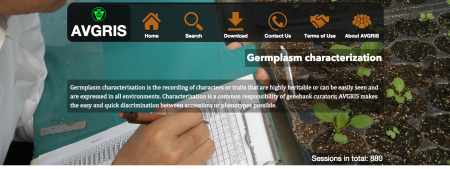- “È curioso che il grano Cappelli, ora diventato un simbolo della “pasta da gourmet”, fosse una volta il comune grano della pasta di tutti i giorni, e che venga da alcuni considerato “autoctono” quando in realtà è una varietà tunisina.” Curious indeed.
- A woman’s crop? Not as straightforward as it may sound.
- State of the World’s Plants symposium, 11-12 May.
- Above will no doubt consider crop wild relatives such as the peanut’s.
- More on the urban vegetable gardens of Istanbul.
- Tree DGs in the garden getting coffee. On International Forest Day.
- The “Bernie Sanders” vision of biofortification.
- Cowpea to get a genome.
- Q&A with John Torgrimson of Seed Savers Exchange.
- The resilience of rice: “You never find a crop that can span this latitude and altitude.” Really? Wheat?
- Cacao and coffee have a microbial terroir.
- Crop mixes are geographically stable.
- Prof. Kathy Willis of Kew on Feeding the World, including using crop wild relatives. IRRI Kew genebanks featured.
- Denmark interprets EU law to allow seed saving.
AVGRIS revamped
The World Vegetable Center has come up with a redesigned front-end for presenting data on its germplasm collection to the world.
The AVRDC Vegetable Genetic Resources Information System (AVGRIS) is an information system that manages the data of all vegetable germplasm conserved in the AVRDC genebank. The Genetic Resources and Seed Unit uses this system to efficiently manage genebank operations. AVGRIS links all germplasm conservation and management operations, from registration, characterization, evaluation and seed inventory to seed distribution to end-users.
Check it out. And before you ask, no, I looked, and Varrone is not there.

Nibbles: CC & death, GBIF enhancements, Killer fungi, Lion trees, Old oaks, Gourmet ganja, Wild horses, Resistant cassava, Contested agronomy, p-values
- Climate change is going to hit us where we live. Or die.
- How to make GBIF more relevant for agrobiodiversity: a 10-point plan.
- Killer fungi on the loose? ‘Twas ever thus. But genomics will save us?
- Planting trees is good for lions too.
- There are still medieval oaks in England.
- “…where sommelier-like ‘budtenders’ sell gourmet ganja in a designer showroom.”
- Rewilding the wild horse.
- More about the cassava variety Kasetsart 50, poster child for CGIAR impact.
- It’s not just genetic resources that are contested. Yep, agronomy too.
- “Scientific conclusions and business or policy decisions should not be based only on whether a p-value passes a specific threshold.”
Cooperation-88 featured in National Geographic
Farmers once cultivated a wider array of genetically diverse crop varieties, but modern industrialized agriculture has focused mainly on a commercially successful few. Now a rush is on to save the old varieties—which could hold genetic keys to de- veloping crops that can adapt to climate change. “No country is self-sufficient with its plant genetic resources,” says Francisco Lopez, of the secretariat of the International Treaty on Plant Genetic Resources for Food and Agriculture. The group oversees the exchange of seeds and other plant materials that are stored in the world’s 1,750 gene banks. — Kelsey Nowakowski
That’s the introduction to a nice feature in the current National Geographic, part of the series The Future of Food. Problem is, I can’t find it online any more. I swear it was there, but it’s not any more. Maybe it was a copyright issue, and it will come back later, when National Gepgraphic is good and ready.
Anyway, the piece is entitled The Potato Challenge:
Potatoes in southwestern China had long been plagued by disease, so scientists began searching for blight-resistant varieties that could be grown in tropical highlands. By the mid-1990s researchers at Yunnan Normal University in China and the International Potato Center (CIP) in Peru had created a new resistant spud using Indian and Filipino potatoes.
The resistant spud is Cooperation-88, of course, and if and when the piece finds its way online you’ll be able to admire some fancy infographics summarizing how it was developed and the impact it has had.
Nibbles: Variety names, Biotech infographic, Satoyama, Wendell Berry, Eating bugs
- Mike Jackson wants to know how many crop varieties you can name. Please tell him. My number is 42.
- This is what CRISPR looks like. In an infographic, that is.
- Japan’s rice terraces were better for biodiversity when they were, you know, full of rice.
- A Wendell Berry biopic?
- Yep, more on eating insects. It’s definitely a thing now.